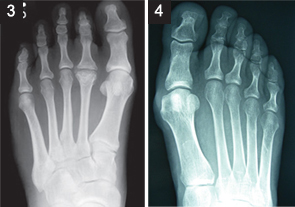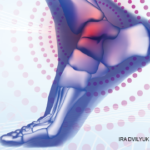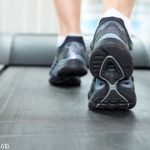Treatment recommendations include a change in footwear (i.e., extra-depth toe box), shoe stretcher, Achilles runner’s or calf stretch (i.e., gastrocnemius-soleus stretch), heel lifts, NSAIDs and shoe inserts with a Morton’s extension (i.e., an extension under the great toe). If pain persists, an intra-articular steroid injection may be helpful. If conservative treatment fails, refer the patient to a podiatrist for a surgical consultation.

Metatarsalgia
With metatarsalgia, there is generalized forefoot pain involving the lesser metatarsals and MTPs. The lateral squeeze test may also elicit pain. The differential diagnosis includes intermetatarsal bursitis, fractures (e.g., traumatic or stress), osteochondritis of the metatarsal head (e.g., Freiberg’s) (see Figure 3, below), bone neoplasm, interdigital neuroma and vascular insufficiency.
Metatarsal stress fractures (see Figure 4, below right) present with swelling, erythema and pinpoint tenderness on the metatarsal shaft. Initial radiographs may not demonstrate any evidence or indication of a stress fracture. Diagnosis is often based on the clinical presentation and the physician’s judgment. Treatment by immobilization in a post-op shoe or short cast boot for four to six weeks is recommended. Interval radiographs can help determine the progression of healing.
Neuroma
Patients with an interdigital neuroma complain of pain, burning and tingling in and around the third interspace radiating to the third and fourth toes, along with a sense of plantar fullness. Manipulation of the interspace resulting in a palpable click that duplicates the pain is known as a Mulder’s sign. Recommendations for treatment include using proper footwear, a metatarsal pad, NSAIDs and Achilles runner’s stretch. A steroid injection to the interspace may be helpful. If these conservative measures fail, the patient may be referred to a podiatrist for surgery.
Rearfoot Problems
The majority of rearfoot problems (e.g., plantar fasciitis, inferior and posterior calcaneal bursitis and Achilles tendonitis) are mechanical in origin. Trauma, neurological conditions and arthritis are other causes of rearfoot pain. Rest, ice, compression, elevation, proper footwear, physical therapy, night splints, NSAIDs, over-the-counter orthotics, orthopedic heel lifts, heel cushions and Achilles calf stretch can be very effective in the treatment of all of these conditions.
If the patient has a posterior heel spur or bursitis, a two-way shoe stretcher and/or a posterior silicon heel protector may be useful.
The Fundamentals
Rheumatologists often see patients who present with forefoot, midfoot and rearfoot conditions unrelated to any rheumatological condition. Key treatment recommendations for all such conditions include the use of properly fitted/supportive footwear and weight loss, along with rest, NSAIDs, stretchers, inserts, orthotics and physical therapy.

